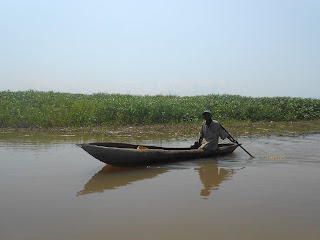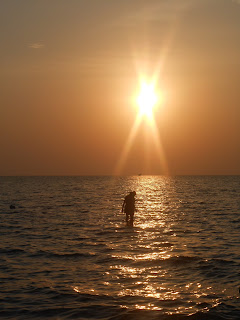Tuesday, June 25, 2013
Monday, June 24, 2013
Little Differences
Dala dalas, tika tikas, and cabies comprise the local transportation in Tanzania. The tika tika are motorcycle taxis that are super dangerous because they just past a law two years ago allowing anyone with a regular license the ability to drive a moto. Needless to say they are visibly unstable and I won't be riding one , whereas the cabies are expensive; but the dalas are fantastic! They are multi-passenger vans originally attended to carry 15 passengers. The buses are about half the size of a 15 passenger van at home and the ceiling as been bubbled out in order to allow for standing. I take a dala to and from work everyday. My stop, Ilemela Mahacama, is the final stop on the route and when I get on at 6:30am there are few passengers. Everyone is sleepy, the conductor usually has his uniform on underneath a coat of some sort, the bus reeks of hot moist breath, pungently filling succumbing stagnant air, unbrushed teeth, sleep still in the air. It is very unpleasant until the wind starts blowing and the crisp morning air takes over. The bus ride usually takes about 35 minutes. Fifteen minutes into the ride there are 20-30 passengers, standing wherever possible, the ones standing in the middle don't need to hold on because they're so crammed in, a solid mass. I get off at the dampo stop, the site of the old city dump that has now been moved (I was surprised that they had a dump to begin with). I have a 20 minute walk up bugando hill to the university hospital. On my ride home I catch the bus at the market and we are packed in like sardines from the beginning. This ride usually takes about an hour and a half due to traffic, even though the ride is only 12km. Today is Monday the 24th of June and the dala I just
got off broke the attendance record that I've witnessed: 35 people! Oh yes and deodorant isn't a thing, so on the ride home in the heat of the day, the smell is not of unbrushed teeth, but of sweaty, hard-working bodies. Africans are nimble, resilient, beautiful!
The pictures above show my house that I live in and a mama cookin chipati! Also a bird that stands as tall as me, the class that we taught and a man frying fish~
One of the biggest differences I've noticed about the developed countries I've visited compared to home is the amount of people outside. People selling, people peddling, people, bargaining, people walking, people talking, people eating, people fighting, mamas carrying their luggage on their head, people laughing, strong people, short people, women and men, children and the elderly, friends and foes but all black and all outside. The streets are lively with communication and companionship. I'm am envious of this aspect of their culture.
Another odd difference of quirk if you will is the way they pronounce English words that were non-existent in Kiswahili or their native tongue. Anything with an e on the end will be pronounced like 'eeee', whereas anything with an i on the end will not pronounced while speaking. For instance, I wrote my name on the board for the class but they call me Lev. But if you want change for the dala it is 'changeeee'.
What I truly dig is the everyday culture, riding in a dala dala, so uncomfortable that my legs are asleep frequently, and you realize that this is what these people do everyday! It's normal... The chaos of the markets and roadways, the strange smell of pollution, body odor, fresh fish, and burning plastic unique to any city in a developing country, the stares from the children you have never seen 'jesus', the happy older men who have come to terms with life and are living it to the fullest, they come up to you and say good morning how is your day, the unclothed children who are digging through garbage for bits of left over food competing with the vultures twice their size, people eating with their hands, but only their right hand because you traditionally wipe with the left, the women carrying anything from a suitcase to a 50 gallon barrel on their heads, ect... These are the sites I enjoy, that really make me think I could live over here for awhile, if only I could convince my friends and family to come along.
Sunday, June 23, 2013
An unexpected Coincidence
Tanzanians are very religious people. About half are Catholic or Christian and the other half are Muslim. For the first couple of weeks I would walk down the street and the people would stare, which I didn't find uncommon because I am a mazungu and there aren't many of us; however, when I met some other mazungus and would walk down the street with them, people were less curious. Then I started walking home with one of the profs,Elias, at the school I'm working with and it would happen again.
What could be the cause of this out-of-the-ordinary attention?
Finally on the second day of walking with the prof, he starts laughing really really hard and I couldn't figure it out, but like usual I was just going to ignore it. After he caught his breath he said 'Levi, do you know why people come up to you and bow and pray? Why the children stare more than normal? Why the sick and the elderly approach you?
THEY THINK YOU'RE JESUS!
So, obviously I learned how to say 'May God bless you my child' in Kiswahili!
Reflections on Eastern Awareness
Tanzania has over one hundred different tribes that all speak their own tongue. The Masai are seemingly the most dominant, at least in the areas that I have been. They don't believe in the modern day monetary system to measure wealth but rather they believe in a system that is based on the size of the herd and the number of wives. Incest is also part of the culture. When a child turns 9 or 10 they are moved from the 'child bed' to their grandparents bed to be accumulated to the sexual ways of the culture, and therefore, no Masai reaches the age of 12 a virgin. Needless to say, cervical cancer is a major public health concern. Another issue arises in the recent westernization of Tanzania. Parents would rather send their children to the city to work (mostly as guards) than sell one of their heads for money because, like I mentioned above, cattle is worth more than paper money. Families are being split apart and I assume the younger kids being sent to the city to work have major self-identity issues.
Regardless of these facts, the Masai warriors have a mystic aura, an ancient power, a calm so unusual and intimidating to a westerner that when the first time I saw one, I was mesmerized, I stopped in mid stride, captured in a vivid trance. This has only ever happened one other time to me and that was when I was hiking through the jungle of Laos and Buddhist Monks were religiously bathing in the waterfall.
The first Masai warrior I met was in Msasani, he had been sent to the city to work as a guard/watchmen. They make remarkable watchmen because from the age of 5 they have a herd of their own in which they walk along the arid steppe to graze. He greeted me with a big smile, the white of his teeth starkly contrasting the rich blackness of his skin. Wearing his traditional red draped blanket, he told me that westerners were to conservative with their clothing choices. His flip-flops were made of leather. He wore finely beaded bone bracelets around his ankles, wrists, and arms, and a bone necklace. His ears were gauged and bone rings the size of lemons inhabited the area. His hair was braided into what looked like a spartan helmet. He carried only a finely carved wooded stick.
The Masai women seem even more powerful. They have all of the aforementioned characteristics. Their hair doesn't grow but but a few centimeters. However, they are easily distinguishable from the males because of their womanly beauty.
Is it my naivety to the cultures I visit that causes me to have these experiences? My lack of research about the indigenous culture? My lack of knowledge of the westernization of the east?
Since I have seen many Masai warriors, Masai women, and other tribes in both rural and urban settings. Both are fascinating for different reasons: In urban settings for the reasons mentioned above and the rural because I get to witness practices that have sustained the test of time for centuries upon centuries. It's amazing the control and connection they have with their cattle, it's almost like they are part of the herd, the leader. The herds consist of cattle, goats, and donkeys. On our recent road trip to the south of the country, the car broke down in the middle of the semi-desert between Dodoma and Mwanza. The houses were made out of red mud, acacia and baobab trees spotted the landscape, and many nomadic herders crossed our path while we waited eight hours for parts and a mechanic to arrive from the nearest village (100km). I followed one of the herds for about an hour, at first observing from a distance, the warrior obviously noticing, and then with the warrior, trying to communicate. Although the national language is Kiswahili, there are over 120 different languages in Tanzania, so the small amount of Kiswahili I have picked up was useless. All I wanted to ask was if he named his animals! Luckily the mechanics able to fix the drive shaft and jump the battery with without using jumper cables. (see picture above, they ended up using 3 wrenches to do the job!!!)
For the past couple of weeks I have been teaching a course at the school of public health in Health GIS. The students are nurses, dentists, MDs, and pharmacists coming back for their MPH and because it is a Catholic University, one of the students is a Nun. She is intelligent, thoughtful, and also has a calm similar to the Monks and Masai. What do all of these people have in common?
I think the Masai,
the Monks, the Nuns, all spend inordinate amounts of time meditating (and I use that word very broadly). The Monks literally meditate, the Masai spend days without anyone except their cattle in a peaceful watch, the Nuns spend 4 hours in the morning and 4 hours in the evening in repetitive prayer. These practices create a self-awareness, an insight, a mindfulness much more powerful than I have witnessed in a lot of western culture.
Friday, June 21, 2013
Subscribe to:
Comments (Atom)





























